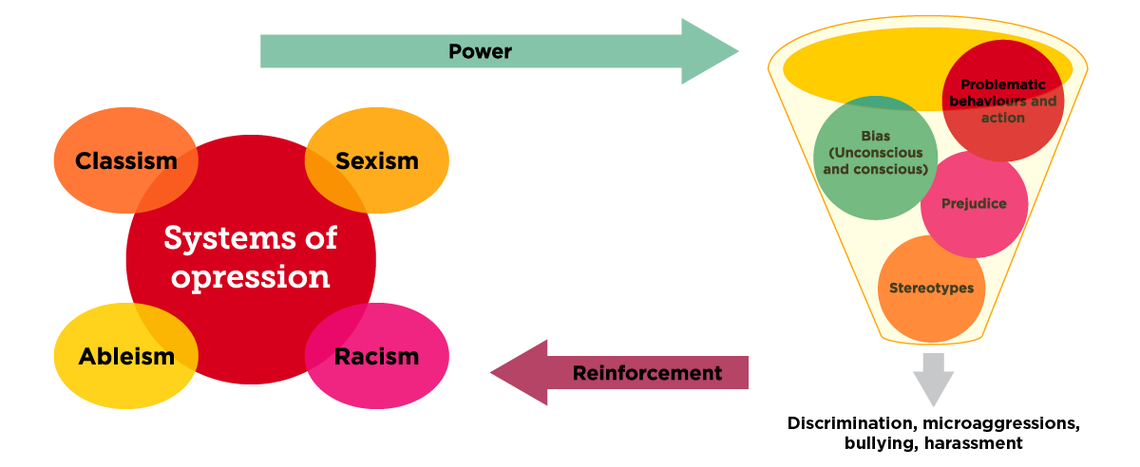What is positionality?
Positionality refers to how we place ourselves in society in relation to others. This is often based on various social factors such as:
EDI stands for equity, diversity and inclusion.
To learn more, please see the EDI Glossary from the Office of Equity, Diversity, and Inclusion.
Positionality refers to how we place ourselves in society in relation to others. This is often based on various social factors such as:

Figure 1: Anti-Racism, EDI, and Positionality – positionality and intersecting identities.
Reflecting on our intersecting identities helps us craft a stronger understanding of our lived experiences, values, and perceptions. Understanding the resulting privilege or oppression attached to our identities is known as intersectionality. This allows us to be more mindful of why we hold certain perceptions or values. Our positionality also influences how we interpret and disseminate knowledge, informing our role as educators.
Take a few moments to pause and reflect on your identities. How do you identify yourself? Then, use the worksheet to map out your social identity. Reflect on your social identity by answering the questions in the worksheet.
Despite our best intentions, the way we perceive and treat others correlates with the stereotypes that we hold to be true. We may see ourselves as inclusive, unbiased individuals. Unfortunately, we may be unaware of internalized stereotypes that influence our perceptions of or actions towards others.
But it is possible to challenge those ingrained, unconscious and reductive stereotypes. By doing so, we can begin to treat people as the complex individuals that they are.
Recognize your biases! When we fail to learn about our biases, we miss opportunities to avoid harm. The Implicit Association Test is an online test that can help you recognize your implicit biases. Try it out below.
Learn how to exchange unconscious biases for different, more inclusive notions. It is possible to challenge those prejudices prior to acting on them. Reading, watching documentaries and listening to podcasts are all accessible ways to extend our knowledge beyond our comfort zone.
Try taking the first-person perspective of a member of a group that you do not identify with. Engaging in real-life, positive interactions with people from varied backgrounds can increase psychological closeness to that group. Increased face-to-face contact with individuals who seem superficially different from you helps undermine implicit bias.
Focus on the individual characteristics of the person interacting with you to prevent group-based stereotypic inferences. Our social identities intersect with multiple social groupings like sexual orientation, ethnicity and gender. Within these multiplicities, we can find shared identities that bring us closer to people. These might include common responsibilities (e.g., parenting), shared interests (e.g., sports teams), or mutual life experiences (e.g., surviving an illness).
Acknowledge that differences exist between people and embrace them. Avoid statements such as “I don’t see colour” or other colour-blind messaging. Statements that welcome and embrace diversity are far more successful at decreasing racial bias.
Adapted from the American Academy of Family Physicians (2019).

Figure 2: Anti-Racism, EDI, and Positionality - this visual representation of the manifestation of inequities demonstrates how biases can create oppression and inequities.
Adapted from “Diversity Recruitment in Higher Education” by Critical Equity Consulting.
Regular reflection on your positionality, assumptions, and bias are necessary starting points for growth. The process is not an easy one. Being open about our biases can trigger defensiveness, doubt and fear. Acknowledging that you participate and benefit from systems that create privilege and advantage can feel threatening or upsetting. This type of work can mean taking a close look at the relationships you have and the institutions you are a part of.
Define EDI and positionality
Map out your social identity by completing the Pause and Reflect worksheet
Consider strategies to mitigate and challenge your own biases
Review additional resources
Association of American Colleges and Universities (AAC&U). (2022). https://www.aacu.org